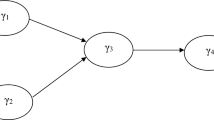Abstract
Generalized structured component analysis has been proposed as an alternative to partial least squares for path analysis with latent variables. In practice, observed and latent variables may often be hierarchically structured in that their individual-level scores are grouped within higher-level units. The observed and latent variable scores nested within the same higher-level group are likely to be more similar than those in different groups, thereby giving rise to the interdependence of the scores within the same group. Unless this interdependence is taken into account, obtained solutions are likely to be biased. In this paper, generalized structured component analysis is extended so as to account for the nested structures of both observed and latent variables. An alternating least-squares procedure is developed for parameter estimation. An empirical application concerning the measurements of customer-level customer satisfaction nested within different companies is presented to illustrate the usefulness of the proposed method.
Similar content being viewed by others
References
Anderson, E.W. & Fornell, C. (2000). Foundations of the American customer satisfaction index. Total Quality Management, 11, 869–882.
Bryk, A.S. & Raudenbush, S.W. (1992). Hierarchical linear models: applications and data analysis methods. Newbury Park: Sage Publications.
Curran, P.J. (1998). Introduction to hierarchical linear models of individual growth: An applied example using the SAS data system. Paper presented at the first international institute on developmental science, University of North Carolina, Chapel Hill.
de Leeuw, J., Young, F.W., & Takane, Y. (1976). Additive structure in qualitative data: An alternating least squares method with optimal scaling features. Psychometrika, 41, 471–503.
Efron, B. (1982). The jackknife, the bootstrap and other resampling plans. Philadelphia: SIAM.
Fornell, C. (1995). The quality of economic output: Empirical generalizations about its distribution and association to market share. Marketing Science, 14, 203–211.
Fornell, C., Johnson, M.D., Anderson, E.W., Cha, J., & Bryant, B.E. (1996). The American customer satisfaction index: Nature, purpose, and findings. Journal of Marketing, 60, 7–18.
Gifi, A. (1990). Nonlinear multivariate analysis. Chichester: Wiley.
Hwang, H. & Takane, Y. (2004). Generalized structured component analysis. Psychometrika, 69, 81–99.
Lohmöller, J.B. (1989). Latent variable path modeling with partial least squares. New York: Springer-Verlag.
McLachlan, G. & Peel, D. (2000). Finite mixture models. New York: John Wiley & Sons.
Searle, S.R. (1971). Linear models. New York: John Wiley & Sons, Inc.
Snijders, T.A.B. & Bosker, R.J. (1999). Multilevel analysis: an introduction to basic and advanced multilevel modeling. London: Sage Publications.
Wedel, M. & Kamakura, W.A. (1998). Market segmentation: conceptual and methodological foundations. Boston: Kluwer Academic Publishers.
Wold, H. (1966). Estimation of principal components and related methods by iterative least squares. In P.R. Krishnaiah (Ed.), Multivariate analysis (pp.391–420). New York: Academic Press.
Wold, H. (1973). Nonlinear iterative partial least squares (NIPALS) modeling: Some current developments. In P.R. Krishnaiah (Ed.), Multivariate analysis (pp.383–487). New York: Academic Press.
Wold, H. (1975). Path models with latent variables: the NIPALS approach. In H.M. Blalock, A. Aganbegian, F.M. Borodkin, R. Boudon, & V. Cappecchi (Eds.), Quantitative sociology: International perspectives on mathematical statistical model building (pp.307–357). New York: Academic Press.
Wold, H. (1982). Soft modeling: The basic design and some extensions. In K.G. Jöreskog & H. Wold (Eds.), Systems under indirect observations: Causality, structure, prediction, Part 2 (pp.1–54). Amsterdam: North-Holland.
Young, F.W. (1981). Quantitative analysis of qualitative data. Psychometrika, 46, 357–388.
Author information
Authors and Affiliations
Corresponding author
Additional information
The work reported in this paper was supported by Grant 290439 and Grant 10630 from the Natural Sciences and Engineering Research Council of Canada to the first and second authors, respectively. We wish to thank Claes Fornell for generously providing us with the ACSI data.
About this article
Cite this article
Hwang, H., Takane, Y. & Malhotra, N. Multilevel Generalized Structured Component Analysis. Behaviormetrika 34, 95–109 (2007). https://doi.org/10.2333/bhmk.34.95
Received:
Revised:
Published:
Issue Date:
DOI: https://doi.org/10.2333/bhmk.34.95




